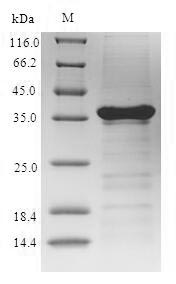This recombinant sarcoplasmic calcium binding protein from Penaeus monodon is produced in E. coli and contains the complete protein sequence spanning amino acids 1 to 193. The protein carries an N-terminal 6xHis-SUMO tag, which makes purification and detection more straightforward. SDS-PAGE analysis indicates the product achieves over 90% purity, likely ensuring reliable results for research applications.
Sarcoplasmic calcium binding proteins appear to be central players in calcium ion regulation within muscle cells. They influence muscle contraction and relaxation processes, though the precise mechanisms may vary across species. Understanding this protein could shed light on calcium dynamics and related pathways, which is why it has become an important subject in physiological and biochemical research focused on calcium-dependent cellular activities.
Potential Applications
Note: The applications listed below are based on what we know about this protein's biological functions, published research, and experience from experts in the field. However, we haven't fully tested all of these applications ourselves yet. We'd recommend running some preliminary tests first to make sure they work for your specific research goals.
Penaeus monodon Sarcoplasmic calcium-binding protein (SCP) is an EF-hand calcium-binding protein that requires precise folding, proper EF-hand domain formation, and specific calcium coordination for its functional activity. The E. coli expression system can produce soluble proteins but may not support optimal calcium-binding functionality without proper metal ion incorporation and oxidative folding conditions. The large N-terminal 6xHis-SUMO tag (∼15 kDa) may sterically interfere with the protein's EF-hand domains and calcium-binding interfaces. While the full-length protein (1-193aa) contains all functional domains, the probability of correct folding with functional calcium-binding activity requires experimental validation.
1. Calcium-Binding Protein Biochemical Characterization
This application carries a significant risk without functional validation. SCP's calcium-binding function requires precise EF-hand domain formation and metal ion coordination. If correctly folded and active (verified through calcium-binding assays), the protein may be suitable for binding studies. If misfolded/inactive (unverified), binding measurements will yield biologically meaningless results. The SUMO tag may sterically interfere with calcium-binding sites.
2. Comparative Evolutionary Studies of Calcium-Binding Proteins
Meaningful comparative studies require native protein conformation and functional activity. If correctly folded and active (verified), the protein enables valid evolutionary comparisons of calcium-binding properties. If misfolded/inactive (unverified), comparative analyses would yield misleading evolutionary insights about SCP conservation and divergence.
3. Antibody Development and Immunological Studies
This application is highly suitable as antibody development relies on antigenic sequence recognition rather than functional protein folding. The full-length protein provides comprehensive epitope coverage for generating SCP-specific antibodies. The high purity (>90%) ensures minimal contamination-related issues during immunization protocols.
4. Protein-Protein Interaction Studies
This application requires proper folding validation. SCP interactions with other proteins require precise tertiary structure and calcium-binding capability. If correctly folded (verified), the protein may identify physiological interaction partners. If misfolded/unverified, there is a high risk of non-specific binding or failure to replicate genuine protein interactions.
5. In Vitro Functional Assays for Calcium Homeostasis Research
This application carries a high risk without functional validation. Calcium homeostasis studies require native protein conformation and proper calcium-binding functionality. If incorrectly folded, the protein will not exhibit authentic calcium-buffering activity and may yield biologically misleading results in functional assays.
Final Recommendation & Action Plan
The E. coli-expressed SCP with a large SUMO tag may not be properly folded for functional applications without experimental validation of calcium-binding capability. Begin with calcium-binding assays (e.g., isothermal titration calorimetry or fluorescence-based titration) to validate functionality before considering Applications 1, 2, 4, and 5. Application 3 (antibody development) can proceed immediately. For critical functional studies, consider removing the SUMO tag to minimize steric interference with calcium-binding domains. Always include appropriate calcium-binding controls and validate key findings with native protein preparations when possible for reliable SCP research.






